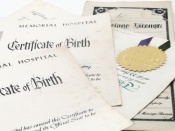Introduction
 Learning objectives: You will learn about the available births and deaths data and how to utilise them in healthcare analysis.
Learning objectives: You will learn about the available births and deaths data and how to utilise them in healthcare analysis.
Information on births and deaths are essential in understanding population growth, for studying health inequalities and population mortality rates.
Read the resource text below.
Resource text
In the UK, registration of birth and death events is a legal requirement. These have to be registered as close as possible to the event (42 days for births and 5 days for deaths). Information on how registration occurs can be found at http://www.gro.gov.uk/gro/content/ .
Births data
 Data on births in England is available publicly on the Office for National Statistics (ONS) website using http://www.statistics.gov.uk/statbase/Product.asp?vlnk=5768. In addition, data may be sourced on stillbirths and infant mortality. The data on births include:
Data on births in England is available publicly on the Office for National Statistics (ONS) website using http://www.statistics.gov.uk/statbase/Product.asp?vlnk=5768. In addition, data may be sourced on stillbirths and infant mortality. The data on births include:
- child's forenames
- sex
- date of birth
- place of birth
- mother's full name and maiden name
- father's full name and occupation if married to the mother
- name, address and relationship to child of the person who registered the birth
- information on marital status and living arrangements of parents
- parents' occupation
- postcode of mother's normal place of residence
(more information available on http://www.familyrecords.gov.uk/topics/bmd_2.htm#birth )
In Scotland the following additional information would be given:
- time of birth
- date and place of parents marriage
Deaths data
Deaths data are passed to ONS on a weekly basis. ONS provide a monthly dataset on deaths to directors of public health, including cause of death and contributing factors. Information on what is captured on the death certificate can be found at http://www.familyrecords.gov.uk/topics/bmd_2.htm#death.
Data on the certificate and the data files available to public health departments includes:
- full name of deceased
- date of death
- address and postcode of normal place of residence
- place of death
- given age
- cause of death, underlying and participatory
- occupation (or name and occupation of husband if the deceased was a married or widowed woman)
- name, address and family relationship (if any) of the person who reported the death.
In Scotland the following additional information would be given:
- marital status
- spouse's name
- sex
- father's name and rank or profession
- mother's name and maiden name
Mortality statistics publications are routinely available from the ONS http://www.statistics.gov.uk/onlineproducts/default.asp#health. The data available include:
DH1 - Annual review of the Registrar General on deaths in England and Wales
DH2 - Deaths by cause
DH3 - Childhood infant and perinatal mortality
DH4 - Injury and poisoning
Public health mortality files contain information about deaths within different health authority boundaries. They also include details about people who died outside the health authority region in which they were normally resident. These files are only available to health authorities and at a cost.
 National births and deaths data are made available to regional Public Health Observatories (PHOs). Mortality data have been linked to Hospital Episode Statistics and are in the process of being made available to PHOs. 2005/6 and historic years' extracts are available with date of death added. Discussions with ONS are ongoing to secure a regular quarterly feed of deaths data that also includes cause and place of death.
National births and deaths data are made available to regional Public Health Observatories (PHOs). Mortality data have been linked to Hospital Episode Statistics and are in the process of being made available to PHOs. 2005/6 and historic years' extracts are available with date of death added. Discussions with ONS are ongoing to secure a regular quarterly feed of deaths data that also includes cause and place of death.
Uses of births and deaths data
Data on births and deaths can help information health service planning, epidemiology, monitoring, and audit as well as assessing progress against planned performance. It may be used to review screening programmes (breast and ovarian cancer, immunisation take-up), assist with confidential enquiries and register checking. The postcode data enable precise geographical analysis of population and patients.
The strengths of these datasets are that both births and deaths data are very complete and accurate for the UK. Deaths data can provide very important information on health of populations.
There are some weaknesses for this data source and this includes the lack of data on ethnicity, which is not collected for either deaths or births (though where these take place in NHS hospitals it may be derived from HES records). In addition, defining the socio-economic status from the occupation recorded on birth registration records is very difficult and possibly even more tenuous for single mothers.
Deaths are not reliable as a picture of burden of morbidity of chronic illness; more people are living longer with illness than in the past; quality of recording cause of death varies considerably.
Related links
http://www.gro.gov.uk/gro/content/
http://www.statistics.gov.uk/statbase/Product.asp?vlnk=5768
http://www.familyrecords.gov.uk/topics/bmd_2.htm#birth
http://www.familyrecords.gov.uk/topics/bmd_2.htm#death
http://www.statistics.gov.uk/onlineproducts/default.asp#health
HES
